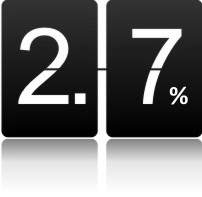What is the House Edge?

If you are new to the world of casino gambling, it is essential that you learn the rules and terminology. Not only does this enable you to get the most out of the game as a player, but it also helps you to understand the precise odds that you face during the course of a game. One of the first terms that you will need to become familiar with is the so-called house edge, which will have a big impact on your experience, probability of winning and the strategy that you use to try to be successful over a period of time. This is closely connected to the probability of you winning the game, of course.
What is the House Edge?
The roulette edge will vary between individual games, although its definition remains the same regardless. More specifically, the house edge refers to the difference that exists between your true probability of winning and the odds that the casino pays out when you win. To understand this better, imagine placing a wager on the outcome of a coin toss. With only two possible outcomes this would be considered as an even money bet, so if you bet a pound and were paid the same amount back you would have been paid out at true odds. If you were only paid out 95 pence instead of the dollar, however, you would have encountered a house edge of 5%. This difference between the amount the casino pays out on a bet and the probability of the bet being successful is the house edge, and it is how the casino makes its money. Think of it as the commission it charges for running the tables, paying the electricity bills and paying the salaries. Plus the profit of course.
Now let’s look at the house edge on one version of roulette, namely the one that originated in Europe and France during the 17th century. As the original version of the game, it is played on a numbered wheel with 37 grooves, including one marked with a single zero. This offers a more favourable house edge of 2.7%, and this variant of the game is less often seen in the U.S., particularly at land-based casinos (you can play European Roulette in Vegas, you just need to hunt around a bit more). While it is available on some high-limit roulette tables where professional players are tempted into placing big bets with the reduced house edge, it is less often seen at regular American tables or tournaments.
Betfair used to run a No Zero Roulette game, but they quietly shelved it in 2013. I guess they were losing money on it.
Generally speaking, the simpler the roulette game, the better for the house edge. Games with a side bet like the Deal or No Deal Roulette game, for example, will have a lower edge than plan old European Roulette. But of course, you don’t need to pace the side bet. These kinds of bets are more like “lottery punts”- if they come in, the payout is big (up to 150x your bet on Deal or No Deal), but the odds are relatively low.
The U.S. House Edge
American Roulette versus European Roulette.
Instead, casinos and operators in the U.S. tend to prefer customers to play American roulette wheel, which includes an additional grove marked with a double zero. This instantly minimises the players’ chances of winning, creating a more competitive game and introducing an inflated house edge of 5.2%, like on this RTG Roulette game, for example. Succeeding on such a wheel requires a great amount of skill and strategy, not to mention a small portion of luck and opportunism. Understanding the house edge is a crucial part of success, however, and something that can make the difference over a prolonged gambling session.
For more insight into the game, head to our roulette glossary which runs through amny of the terms and slang you’ll hear around the table.

